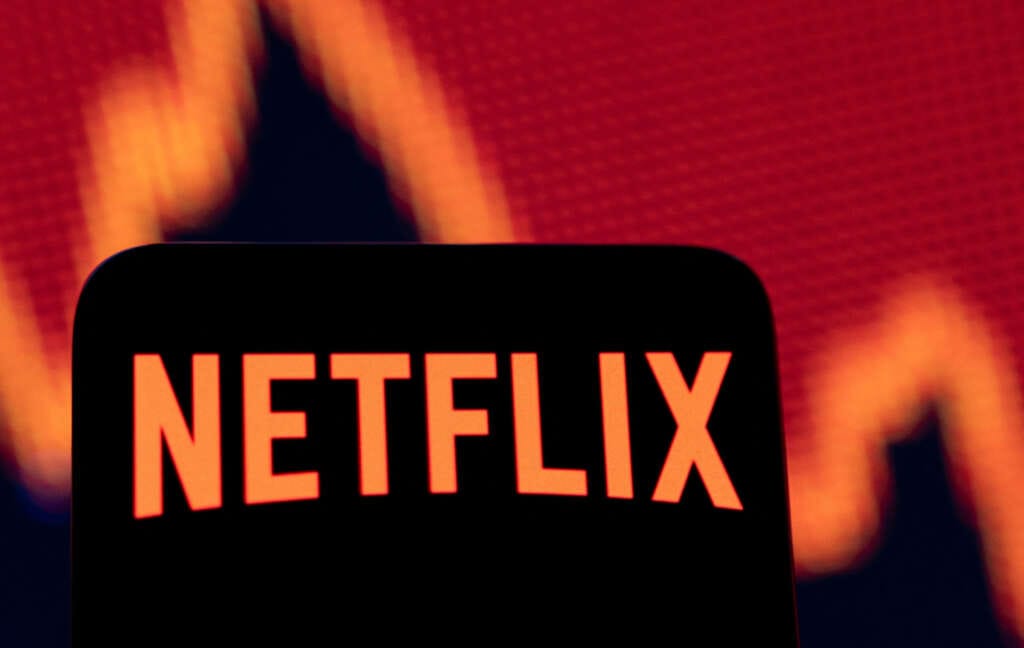
By Eva Mathews
(Reuters) – Netflix Inc is expected to report its slowest quarterly revenue growth on Thursday as its ad-supported plan struggles to attract customers in the saturating U.S. market, which could pressure the company to pull back on content spending this year.
The streaming pioneer has been reeling under strained consumer spending, rising costs of financing production and increased competition from Disney+ and Amazon Prime.
It had pinned its hopes on the launch of the ad-supported tier, but analysts say they have not seen a burst of subscriptions.
The company is expected to have added 4.5 million subscribers in the fourth quarter – the lowest addition for the holiday period since 2014. It added 8.3 million subscribers a year ago.
Graphic 3: Netflix set for lowest subscriber additions for Q4 since 2014, https://www.reuters.com/graphics/NETFLIX-SUBSCRIBERADDITIONS/lbpggowxnpq/chart_eikon.jpg
The $6.99 per month ad-supported plan does not have access to all titles and is not cheap enough to win over significant numbers of customers in the United States and Canada, analysts say.
“Looking at the saturation of the market and the variety of different options available, and the fact that the pricing is not necessarily significantly below the competition, there are some challenges in attaining those subscriber targets,” said Jamie Lumley, an analyst at Third Bridge.
That is likely to draw focus on Netflix’s aggressive content spending, which finance chief Spencer Neumann said in July would total about $17 billion annually for the next couple of years.
“When debt was cheap, you could go and borrow a lot of money and invest that in content,” said Shahid Khan, partner and global head of media and entertainment at Arthur D. Little.
“Given current interest rates, Netflix will have to be very selective about green-lighting content and how they would finance it.”
For comparison, rival Walt Disney Co expects fiscal 2023 content spend in the low $30 billion range, while Paramount Global projects expenditure of below $10 billion. Disney does not break out content expenditure between streaming and its other divisions.
CONTEXT
Netflix had suffered hefty subscriber losses in the first six months of 2022 due to the fallout from the Russia-Ukraine conflict and a weakening economy, which forced the streaming pioneer to turn to advertising in a move it long resisted.
It returned to subscriber growth in the third quarter, but its stock, an investor favorite during its years of rapid growth, still ended the year with a drop of more than 50%.
The company’s revenue is expected to have risen just 1.7% to $7.84 billion in the October-December quarter, according to Refinitiv. That would be the lowest since it went public in 2002.
“As overall streaming growth flattens out, most of the more mature streaming platforms have leveled off as well,” MoffettNathanson said, adding that Netflix’s reach fell by 200 basis points in the quarter.
Graphic 2: Netflix set to report slowest revenue growth in 20 years, https://www.reuters.com/graphics/NETFLIX-REVENUE/akveqanrzvr/chart.png
Still, some analysts believe that the ad-supported plan will pay off in the long run, especially in developing markets, where spending power is weaker.
FUNDAMENTALS
* Earnings per share are estimated at 44 cents when Netflix reports results on Jan. 19
Graphic 1: Streaming stocks in 2022, https://www.reuters.com/graphics/NETFLIX-STOCKS/egpbymlwovq/Pasted%20image%201673959817956.png
WALL STREET SENTIMENT
* 21 of 43 analysts rate the stock “buy” or higher, while 19 have a “hold” rating and three rate it “sell” or lower
* The analysts’ median price target on the stock is $330, up from $278.97 on Nov. 1, when the ad plan was launched
* Netflix is currently trading at $324.43
QUARTER ENDING REFINITIV IBES ACTUAL BEAT, MET,
ESTIMATE MISSED
Sep. 30 2022 2.13 3.10 Beat
Jun. 30 2022 2.94 3.20 Beat
Mar. 31 2022 2.89 3.53 Beat
Dec. 31 2021 0.82 1.33 Beat
Sep. 30 2021 2.56 3.19 Beat
Jun. 30 2021 3.16 2.97 Missed
Mar. 31 2021 2.97 3.75 Beat
Dec. 31 2020 1.39 1.19 Missed
(Reporting by Eva Mathews in Bengaluru; Editing by Aditya Soni and Maju Samuel)


